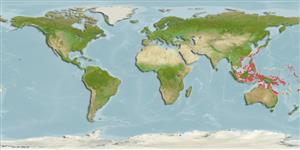>
Ovalentaria/misc (Various families in series Ovalentaria) >
Pomacentridae (Damselfishes) > Pomacentrinae
Etymology: Dischistodus: Greek, di = two + Greek, schistos = fissile stone, Plinius + Greek, odous = teeth (Ref. 45335).
More on author: Bleeker.
Environment: milieu / climate zone / depth range / distribution range
Ecología
marino asociado a arrecife; no migratorio; rango de profundidad 1 - 12 m (Ref. 9710). Tropical; 35°N - 25°S
Western Pacific: southern Japan and the Ryukyu Islands, Taiwan, Philippines, Palau, Indonesia, Papua New Guinea, Solomon Islands, and the Great Barrier Reef. Reported from Vanuatu (Ref. 13300).
Tamaño / Peso / Age
Maturity: Lm ? range ? - ? cm
Max length : 16.0 cm TL macho / no sexado; (Ref. 9710)
Espinas dorsales (total): 13; Radios blandos dorsales (total): 13-15; Espinas anales 2; Radios blandos anales: 13 - 14. Adults have a large black patch on the abdomen reaching the anus; juveniles an ocellus over the center of the dorsal fin base (Ref. 48636). Body white, anterodorsal (or sometimes entire half of body) dark brown, opercle spots prominent pale large, belly patch dark brown. Body depth 2.0-2.1 in SL (Ref. 90102).
Adults occur in lagoon reefs and generally prefers small patch reefs with sand or rubble substrates (Ref. 1602). Feed on benthic algae which it aggressively guards against other herbivores (Ref. 9710). Juveniles secretive in rubble (Ref. 48636). Oviparous, distinct pairing during breeding (Ref. 205). Eggs are demersal and adhere to the substrate (Ref. 205). Males guard and aerate the eggs (Ref. 205). Diurnal species (Ref. 113699).
Life cycle and mating behavior
Madurez | Reproducción | Puesta | Huevos | Fecundidad | Larva
Oviparous, distinct pairing during breeding (Ref. 205). Eggs are demersal and adhere to the substrate (Ref. 205). Males guard and aerate the eggs (Ref. 205).
Allen, G.R., 1991. Damselfishes of the world. Mergus Publishers, Melle, Germany. 271 p. (Ref. 7247)
IUCN Red List Status (Ref. 130435)
Threat to humans
Harmless
Human uses
Más información
ReferenciasAcuiculturaPerfil de acuiculturaRazasGenéticaElectrophoresesheritabilidadEnfermedadesProcesamientoNutrientsMass conversion
Herramientas
Special reports
Download XML
Fuentes de Internet
Estimates based on models
Preferred temperature (Ref.
123201): 25.2 - 29.3, mean 28.6 °C (based on 1860 cells).
Phylogenetic diversity index (Ref.
82804): PD
50 = 0.5078 [Uniqueness, from 0.5 = low to 2.0 = high].
Bayesian length-weight: a=0.02818 (0.01498 - 0.05302), b=3.01 (2.84 - 3.18), in cm total length, based on LWR estimates for this species & (Sub)family-body (Ref.
93245).
Nivel trófico (Ref.
69278): 2.0 ±0.00 se; based on food items.
Resiliencia (Ref.
120179): Medio, población duplicada en un tiempo mínimo de 1.4-4.4 años (Preliminary K or Fecundity.).
Fishing Vulnerability (Ref.
59153): Low vulnerability (10 of 100).
Nutrients (Ref.
124155): Calcium = 93.7 [45.9, 157.0] mg/100g; Iron = 0.72 [0.43, 1.24] mg/100g; Protein = 18 [17, 19] %; Omega3 = 0.09 [0.05, 0.15] g/100g; Selenium = 22.4 [11.9, 46.0] μg/100g; VitaminA = 69.9 [16.1, 275.8] μg/100g; Zinc = 1.88 [1.24, 2.85] mg/100g (wet weight);
